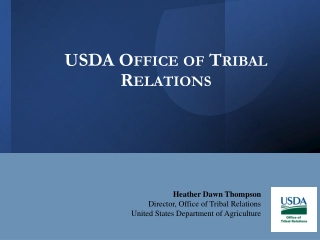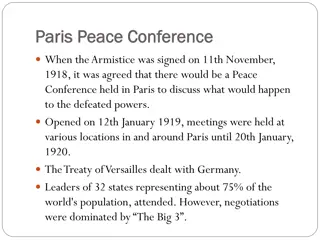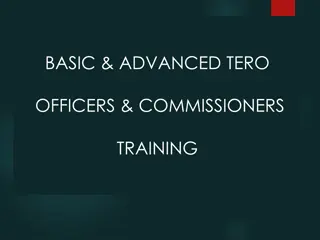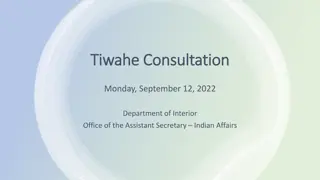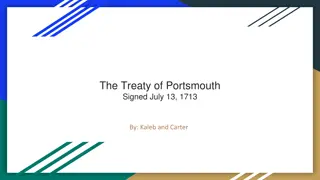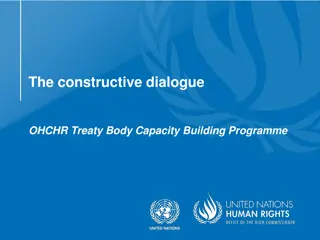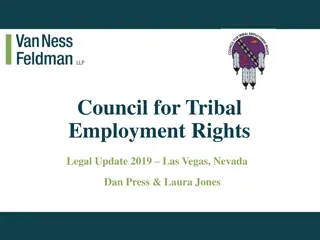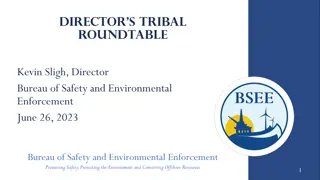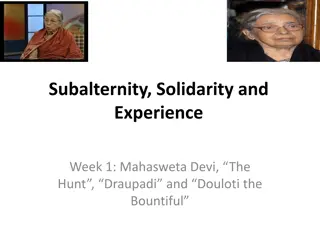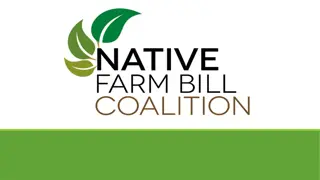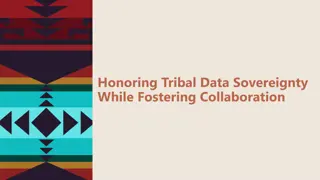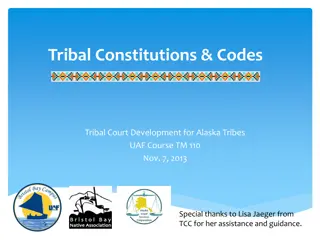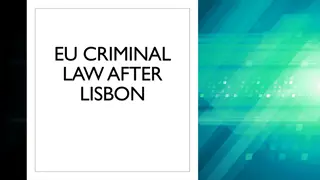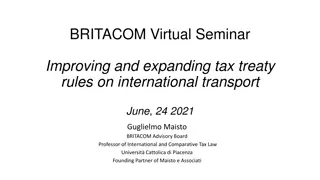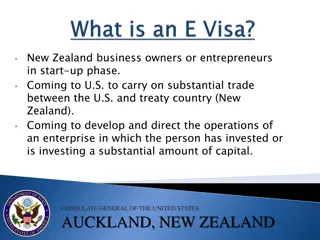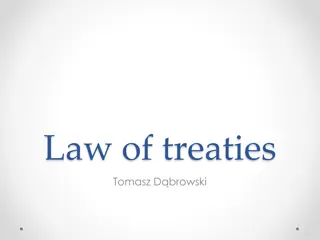The Legacy of DAPL: Protecting Treaty Rights and Tribal Resources
Explore the background and lessons from the DAPL controversy, emphasizing the significance of tribal consultation, treaty rights, and the protection of sacred lands like Mni Sose. Gain insights into the challenges faced by indigenous communities and the ongoing efforts to uphold their rights and preserve their cultural heritage.
Download Presentation

Please find below an Image/Link to download the presentation.
The content on the website is provided AS IS for your information and personal use only. It may not be sold, licensed, or shared on other websites without obtaining consent from the author. Download presentation by click this link. If you encounter any issues during the download, it is possible that the publisher has removed the file from their server.
E N D
Presentation Transcript
The Legacy of DAPL: Background and Lessons for Protecting Treaty Rights, Tribal Trust Resources, and Grandmother Earth Through Government-to- Government Consultation Nicole E. Ducheneaux Partner
I.The atrocities at Standing Rock a case study in consultation II. Origins and fundamentals of tribal consultation III. DAPL litigation remand and litigation moving forward IV. DAPL lessons learned the post-Standing Rock relationship with agencies, consultation, and litigation
PART I: THE ATROCITIESAT STANDING ROCK: A CASE STUDYIN CONSULTATION
LAKOTA TERRITORY PURSUANTTO 1851 FORT LARAMIE TREATY
SIGNIFICANCEOF TREATY TERRITORY Homeland absolute and undisturbed use and occupation Culture and livelihood hunting, fishing, subsistence Spirituality Sacred Black Hills; sacred water
STATUSOF INDIAN LANDS Ultimately and illegally diminished to present-day reservations United States owns in trust, including resources like water, for the benefit of Tribes and owes a fiduciary responsibility (Johnson v. M Intosh, 21 U.S. 543 (1823) Treaty rights not explicitly abrogated, including off-reservation rights, remain in force (see, e.g. Minnesota v. Mille Lacs Band of Chippewa Indians, 526 U.S. 172 (1999))
1851 TERRITORYWITH PRESENT-DAY RESERVATIONSAND DAPL
THE MISSOURI RIVER LAKE OAHE MNI SOSE
IMPORTANCEOFMNI SOSE The lifeline or blood line of the Lakota from time immemorial Sacred sites, cultural sites, archeological sites, graves Sole source of clean, fresh drinking water Subsistence and culture hunting, fishing, gathering plants and medicines Religion and sacraments water is our first medicine
DAPL FACTS 1,200-mile pipeline designed to move over 500,000 gallons of crude oil from Bakken oilfields in North Dakota to Illinois daily Permit under Section 408 of the Rivers and Harbors Act (33 U.S.C. 408) required for occupation or alteration of Corps project Easement required under the Mineral Leasing Act, 30 U.S.C. 185, to cross Corps land Verification that activities satisfied terms of Nationwide Permit 12 for other miscellaneous WOTUS crossings NHPA Section 106 Process: scoping, identification of historic properties, assessment and resolution of adverse effects based on consultation
COMPARISONWITH KXL (HOW DISGUSTING, RIGHT???)
DAPL CROSSING SIGNIFICANCETO LAKOTA Confluence of Missouri and Cannonball Rivers Historic campsite of the people from time immemorial Sacred site where whirling eddy had worn small boulders into perfectly round spheres (hence Cannonball river) Location of numerous graves and stone cairns in the vicinity
DEFICIENCYOF SECTION 106 PROCESS Generic form letter to Tribes Initial cultural surveys accomplished without tribal involvement Failure of government to respond to tribal requests for consultation Focus primarily on SRST, despite legal interest of all signatories to 1851 and 1868 Treaties with the Sioux Public comment sessions versus meaningful government-to-government consultation Results of private archeological surveys done by non-tribal consultants, no tribal input regarding protocols or the area of potential effects Failure to credit tribal experts, both traditional and academic and failure to assess sites identified by tribal experts Failure to consider sites outside of bore pits Disgraceful conclusion that no historic properties affected
THE TERRIBLE PARADOX OFTHE RECORDS Insufficient consultation resulted in a lack of record to demonstrate the existence of important cultural and historical sites; BUT When we added specific detail to the record at the last minute, it was used against us to disastrous effect
A LABOR DAY WEEKEND TRAGEDY SRST Motion for Preliminary Injunction re: NHPA fully briefed and argued on August 24, 2016 August 28, 2016, landowner contacts SRST to advise that he had identified various stone cairn sites on his land along pipeline corridor SRST THPO and consultant visit site and identified numerous significant cultural sites, including stone cairn/effigies and burial sites Friday, September 2, 2016, SRST files supplemental declaration setting forth descriptions, locations, and graphs demonstrating nature and location of newly discovered sacred sites along pipeline corridor. Saturday, September 3, 2016, DAPL plows directly through the newly discovered sites
CLASHESON SEPTEMBER 3, 2016 PART I
CLASHESON SEPTEMBER 3, 2016 PART II
CLASHESON SEPTEMBER 3, 2016 PART III
CLASHESON SEPTEMBER 3, 2016 PART IV
RESULTSOFTHE FLAWED CONSULTATION PROCESS Untold historically and culturally significant sacred sites and objects destroyed with no real penalty to oil company Motion for Preliminary Injunction denied on September 9, 2016 on the grounds that consultation was sufficient
OTHER IMPORTANT POST- CONSULTATION ISSUESOF NOTE Obama time-out provided tribes with extra time to paper administrative record And we won! (Sort of..) Early 2017 RFRA issues. Hard fight and we lost, because of lack of record on religious beliefs
PART II: THE ORIGINSAND FUNDAMENTALS OF TRIBAL CONSULTATION
CONSULTATIONWITH TRIBES Necessary because of Treaty rights, trust responsibility, and cultural, political, and public health consequences
INTERNATIONAL CONSULTATION PRINCIPLES United Nations Declaration on the Rights of Indigenous People (UNDRIP), September 13, 2007 Article 10: Indigenous peoples shall not be forcibly removed from their lands or territories. No relocation shall take place without the free, prior and informed consent of the indigenous peoples concerned . . . .
UNITED STATES GENERAL TRIBAL CONSULTATION REQUIREMENTS United States required to consult with tribes as to impacts on tribal treaty rights and trust resources as a function of those treaty rights and the United States trust responsibility this is sufficient to require such consultation In light of the gravity of rights involved, this should require free, prior, and informed consent
UNITED STATES VIEWOF ITS TRIBAL CONSULTATION OBLIGATION Despite general duty, the U.S. usually sees its obligation as limited to Tribal consultation also required as to impacts on tribal treaty rights as an inherent corollary and trust resources, Executive Order 13175, and related agency regs but largely toothless and unenforceable Tribal consultation statutorily required by Section 106 of the National Historic Preservation Act as to historic properties that have religious and cultural significance to Indians Free, prior and informed consent, not required; just consultation
TRIBAL CONSULTATIONON DAPL Corps, with DAPL archeologists, engaged in tribal consultation per the NHPA in a manner that Tribes felt was grossly deficient Corps made no explicit or affirmative efforts to engage in tribal consultation as to treaty rights or trust resources; considered no tribal input on impact of spill on water or treaty rights
DISCRETE LESSONSOF DAPL CONSULTATION We lost on NHPA explicit statutory provisions did nothing to protect us from inadequate consultation efforts on sacred sites and deliberate destruction of our sacred sites. We won on the Treaties let us not forget that not only are Treaties the Supreme Law of the Land, but our ancestors fought and died for those rights. The requirement to consult under our Treaties is POWERFUL AND SACRED.
A CAVEAT Don t get me wrong about NHPA, it s super, super important and a powerful arrow in our quiver. All I mean, is don t forget the profound power of our Treaties
PART III: CONSULTATION BEST PRACTICES: HOLDINGTHE GOVERNMENTTO ITS OBLIGATIONSAND CREATINGA RICH RECORD FOR YOUR FIGHT
LESSONS LEARNED FROM DAPL CULTURAL COMPETENCYOF YOUR ATTORNEY Where the buffalo roam .. Your tribal traditions and culture are the focus of this fight and they cannot be entrusted to an attorney who neither understands nor cares about them they are your voice.
LESSONS LEARNED FROM DAPL: TRIBAL ENGAGEMENTIN CONSULTATION Insist upon proper consultation and be clear about the Tribe s terms (in formal consultation policy); React every time, and do it early time, often, and uniformly to the extent possible Utilize experts tribal, scientific, cultural, non-tribal; Flex treaty rights, Winters rights, sovereign rights.
LESSONS LEARNED FROM DAPL: CREATINGA TRIBAL CONSULTATION POLICY Flex your tribe s sovereignty create positive law, including a formal consultation policy that reflects your treaty rights and the government s trust responsibility One size does not fit all consider your specific treaties, your specific culture, and yourtribe s traditions and political landscape We don t have to rely on the United States to dictate to us what consultation means. Some tribal laws stand on an equal footing with federal law and will be enforceable in federal court, e.g., tribal constitutions
SAMPLE CONSULTATION POLICY COMPONENTS PART I Provide the Tribe with and explain all pertinent information concerning the impact on the Tribe s rights before consultation in a timely manner. Coordinate with the Tribe before consultation begins, especially with development of an agreement on consultation timelines. Consult only with Tribal representatives who have been authorized to engage in government-to-government consultation by the Tribal government. Make every effort to conduct Tribal consultation at the seat of Tribal government or elsewhere within the Tribe s territory.
Sample Consultation Policy Components Part II Ensure that federal participants in Tribal consultation have actual decision-making authority. Provide written confirmation that the agency has considered tribal comments and concerns and the agency s response, whether positive or negative. Obtain resolution of approval from the Tribe that the agency has satisfactorily consulted with the Tribe and the Tribe agrees with the agency s response to Tribal concerns in each instance.
Lessons Learned From DAPL: Reacting Early and Often Work with THPO to create a system to track ALL Dear Tribal leader letters, impact, and responses never miss one Work with THPO and other cultural and historical experts to create a boiler plate initial comment letter and consultation request to ensure that the proper legal and factual bases are transmitted to various agencies without requiring the tribe to reinvent the wheel every time and amass huge legal bills
WHY IT ALL MATTERS Tribal (human?) existence depends on clean environment health, welfare, economy; Threats to the environment are real human error; when, not if; Real world consequences effects on major organs, birth defects, genotoxicity.
CONCLUSION Mni wiconi! Water is life! Wopila tanka. Thank you very much.


